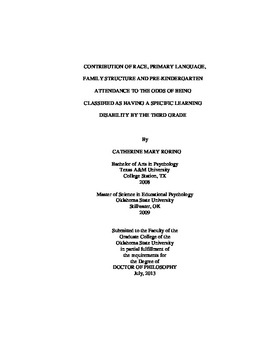| dc.contributor.advisor | Yetter, Georgette | |
| dc.contributor.author | Roring, Catherine Mary | |
| dc.date.accessioned | 2014-09-24T14:17:05Z | |
| dc.date.available | 2014-09-24T14:17:05Z | |
| dc.date.issued | 2013-07 | |
| dc.identifier.uri | https://hdl.handle.net/11244/11039 | |
| dc.description.abstract | Many risk factors have been identified for children entering Kindergarten. Many at-risk children eventually get classified as having a Specific Learning disability. Some of these risk factors include having a primary home language other than English (Hosp & Reschly, 2004), having non-intact families (Pong, 1997), being of minority status (Losen & Orfield, 2002; Morgan, Farkas and Hibel, 2008) and not attending a quality pre-school (Lee, 2010). | |
| dc.description.abstract | This study analyzed ECLS-K data to examine the extent to which race, family composition, primary home language, and pre-kindergarten attendance predict the likelihood of children being classified with a specific learning disability (SLD) by spring of third grade. Four logistic regressions were completed: one which analyzed for the entire sample and three others which separately analyzed these predictive variables for students attending low, medium, and high poverty schools. When analyzing the entire model, these predictors were not found to have much power, however when each SES group were analyzed, interesting results were found. | |
| dc.description.abstract | In low SES schools, students who were minorities had odds twice as high as those who were White of being classified SLD, and those who did not speak English as their primary language had odds that were three times as high. Having attended Pre-K lowered these students' odds of being labeled. In middle SES schools, once again non-English as the primary language led to higher odds of being classified SLD, but race had an opposite trend, with White children having higher odds of being given this label. In the wealthiest schools, coming from a non-intact family actually led to lower rates of classification as SLD, as did not speaking English at home. | |
| dc.format | application/pdf | |
| dc.language | en_US | |
| dc.rights | Copyright is held by the author who has granted the Oklahoma State University Library the non-exclusive right to share this material in its institutional repository. Contact Digital Library Services at lib-dls@okstate.edu or 405-744-9161 for the permission policy on the use, reproduction or distribution of this material. | |
| dc.title | Contribution of race, primary language, family structure and pre-kindergarten attendance to the odds of being classified as having a specific learning disability by the third grade | |
| dc.contributor.committeeMember | Stinnett, Terry A. | |
| dc.contributor.committeeMember | Duhon, Gary J. | |
| dc.contributor.committeeMember | Mwavita, Mwarumba | |
| osu.filename | Roring_okstate_0664D_12962.pdf | |
| osu.accesstype | Open Access | |
| dc.type.genre | Dissertation | |
| dc.type.material | Text | |
| thesis.degree.discipline | School Psychology | |
| thesis.degree.grantor | Oklahoma State University | |
